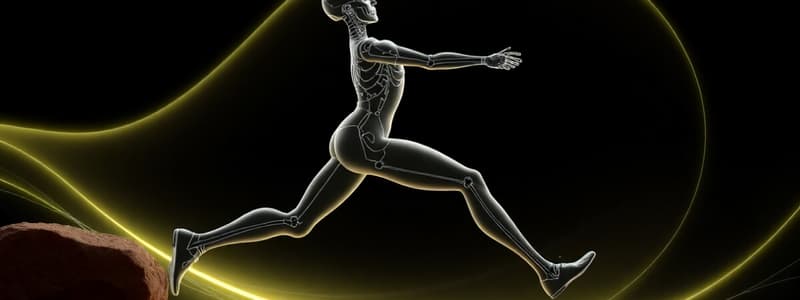Podcast
Questions and Answers
What does Newton's First Law of Inertia state about an object at rest?
What does Newton's First Law of Inertia state about an object at rest?
- It will start moving spontaneously after a period of time.
- It will move in a circular motion unless acted upon by an external torque.
- It will remain at rest unless acted upon by a net external force. (correct)
- It will eventually accelerate if unbalanced forces act upon it.
Which statement best describes the term 'inertia'?
Which statement best describes the term 'inertia'?
- It refers to the speed of an object in motion.
- It is the capability of an object to maintain constant speed regardless of mass.
- It is the force required to change an object's state of motion.
- It represents an object's resistance to a change in velocity. (correct)
In terms of motion, what is required to change the state of an object in linear motion according to Newton's laws?
In terms of motion, what is required to change the state of an object in linear motion according to Newton's laws?
- An external force is necessary. (correct)
- Friction is sufficient to change its state of motion.
- No force is required if the object is already in motion.
- Only constant acceleration is required.
What is the relationship between inertia and mass?
What is the relationship between inertia and mass?
Which of the following scenarios best illustrates Newton's Third Law of action-reaction?
Which of the following scenarios best illustrates Newton's Third Law of action-reaction?
Which statement best describes the relationship between net force and mass in the context of Newton's Second Law?
Which statement best describes the relationship between net force and mass in the context of Newton's Second Law?
Which of the following correctly describes what happens when two objects interact concerning their masses?
Which of the following correctly describes what happens when two objects interact concerning their masses?
What does the term 'ground reaction force' specifically refer to?
What does the term 'ground reaction force' specifically refer to?
In the context of Newton's Second Law, how does mass affect acceleration?
In the context of Newton's Second Law, how does mass affect acceleration?
What role does co-contraction play in joint reaction force?
What role does co-contraction play in joint reaction force?
What effect do the hamstrings have on the anterior translation of the tibia in relation to the femur?
What effect do the hamstrings have on the anterior translation of the tibia in relation to the femur?
In static equilibrium, what can be said about the vertical velocity and net force?
In static equilibrium, what can be said about the vertical velocity and net force?
What happens to the force of air resistance when the parachute opens during a fall?
What happens to the force of air resistance when the parachute opens during a fall?
What is primarily responsible for the co-activation of the hamstrings and quadriceps during movement?
What is primarily responsible for the co-activation of the hamstrings and quadriceps during movement?
In dynamic equilibrium during free fall, what must be true about the forces acting on the falling body?
In dynamic equilibrium during free fall, what must be true about the forces acting on the falling body?
Which of the following best describes the motion of an object when it has a large moment of inertia (I) and small angular velocity (ω)?
Which of the following best describes the motion of an object when it has a large moment of inertia (I) and small angular velocity (ω)?
What occurs during the first jump out of a plane in regard to gravitational forces?
What occurs during the first jump out of a plane in regard to gravitational forces?
Which situation represents a state of static equilibrium?
Which situation represents a state of static equilibrium?
What is the primary factor that determines the moment of inertia of an object?
What is the primary factor that determines the moment of inertia of an object?
In dynamic equilibrium, which of the following statements is incorrect?
In dynamic equilibrium, which of the following statements is incorrect?
Given the equation for torque ($τ = Iω$), what does a large moment of inertia imply about an object's angular acceleration?
Given the equation for torque ($τ = Iω$), what does a large moment of inertia imply about an object's angular acceleration?
In static equilibrium, which scenario is not a requirement for a body?
In static equilibrium, which scenario is not a requirement for a body?
Which statement best describes the relationship between mass moment of inertia and angular acceleration in a diving scenario?
Which statement best describes the relationship between mass moment of inertia and angular acceleration in a diving scenario?
What condition must be met for an object to accelerate according to Newton's Second Law?
What condition must be met for an object to accelerate according to Newton's Second Law?
Which of the following statements about air resistance in a falling context is false?
Which of the following statements about air resistance in a falling context is false?
Which scenario best illustrates the concept of static equilibrium?
Which scenario best illustrates the concept of static equilibrium?
Flashcards
Inertia
Inertia
The tendency of an object to resist changes in its motion.
Newton's First Law (Law of Inertia)
Newton's First Law (Law of Inertia)
An object at rest will stay at rest, and an object in motion will stay in motion at a constant velocity, unless acted upon by a net external force.
Inertia (Quantitative Definition)
Inertia (Quantitative Definition)
The measure of an object's resistance to changes in its linear velocity.
Force (Linear Motion)
Force (Linear Motion)
Signup and view all the flashcards
Torque (Rotational Motion)
Torque (Rotational Motion)
Signup and view all the flashcards
Moment of Inertia
Moment of Inertia
Signup and view all the flashcards
Static Equilibrium
Static Equilibrium
Signup and view all the flashcards
Dynamic Equilibrium
Dynamic Equilibrium
Signup and view all the flashcards
Torque
Torque
Signup and view all the flashcards
Angular Acceleration
Angular Acceleration
Signup and view all the flashcards
Newton's Second Law for Rotational Motion
Newton's Second Law for Rotational Motion
Signup and view all the flashcards
Factors Affecting Moment of Inertia
Factors Affecting Moment of Inertia
Signup and view all the flashcards
Net Force
Net Force
Signup and view all the flashcards
Acceleration
Acceleration
Signup and view all the flashcards
Ground Reaction Force
Ground Reaction Force
Signup and view all the flashcards
Joint Reaction Force
Joint Reaction Force
Signup and view all the flashcards
ACL Function
ACL Function
Signup and view all the flashcards
Hamstring Role in ACL Support
Hamstring Role in ACL Support
Signup and view all the flashcards
Moment of Inertia (I)
Moment of Inertia (I)
Signup and view all the flashcards
Angular Velocity (ω)
Angular Velocity (ω)
Signup and view all the flashcards
Relationship between I and ω
Relationship between I and ω
Signup and view all the flashcards
Inverse Proportional Relationship between I and ω
Inverse Proportional Relationship between I and ω
Signup and view all the flashcards
Study Notes
Movement Science Session II: Newton's Laws
- Objectives include describing force, motion, levers and biomechanical components, applying kinesiological principles of kinematics and biomechanics to movement dysfunction, and analyzing kinetic and kinematic factors influencing movement.
Perspective
- A Family Guy cartoon image is used as a visual aid.
Laws Governing Motion
- Newton's Laws are presented:
- First Law (Inertia): Objects at rest stay at rest, objects in motion stay in motion (with constant velocity) in a straight line unless acted upon by a force. Linear motion requires force: to start, stop, accelerate, and decelerate. Rotational motion requires torque: to start, stop, accelerate, and decelerate.
- Second Law: The acceleration of an object is directly proportional to the net force acting on it and inversely proportional to its mass. The acceleration takes place in the same direction as the net force or torque.
- Third Law (Action-Reaction): For every action, there is an equal and opposite reaction. When two objects interact, each experiences a force that is dependent on its mass.
Newton's First Law: Law of Inertia
- Inertia is the resistance of an object to a change in its velocity. Linear inertia is proportional to mass, and measured in the same units as mass (e.g., kg). Rotational inertia is proportional to both mass and the distribution of that mass (m*r²).
Equilibrium
- Static Equilibrium: No linear or rotational acceleration (body is stationary. The sum of forces in all directions (ΣFx = 0, ΣFy = 0) and the sum of torques (Στ=0) are zero.
- Dynamic Equilibrium: Constant linear or rotational velocity. The sum of forces (ΣFx = 0, ΣFy = 0) and the sum of torques (Στ=0) are zero. No acceleration.
Newton's Third Law
- For every action, there is an equal and opposite reaction.
- When two objects interact, the forces each experience are dependent on their mass.
- Applications include ground reaction force, and joint reaction force.
Ground Reaction Force
- The force exerted by the ground on the body, equal in magnitude and opposite in direction to the force the body applies to the ground.
Joint Reaction Force
- The force between the surfaces of a joint, developing in reaction to other forces.
- It's usually the difference between muscle forces and external forces. This difference can cause acceleration or deceleration effects.
Opposing Forces: Co-Contraction
- Co-contraction (activation of opposing muscle groups) helps control joint movement during tasks.
- The quadriceps pull the tibia anteriorly and the hamstrings pull the tibia posteriorly. This coordinated action reduces the force on, and thereby provides increased stability for the ACL.
Demonstrations/Visual Aids
- The notes include various demonstrations(visual aids) to explain the concepts, including a video link. Some of these may display scenarios like a person jumping out of an airplane and the effects of gravity and air resistance.
Studying That Suits You
Use AI to generate personalized quizzes and flashcards to suit your learning preferences.




